73.1 Deploying Workstation Inventory
The following sections help you to deploy Workstation Inventory:
IMPORTANT:The recommendations discussed in the scenarios are generic. Based on the topology of your enterprise, further refinements might become necessary.
73.1.1 Simple Deployment
In the example scenario, the network consists of a single site and up to 5000 inventoried workstations. The Inventory server components and the database are located on a Standalone Server, and the inventoried workstations send scans to the Standalone server.
This scenario is illustrated in the following figure.
Figure 73-1 Simple Workstation Inventory Deployment
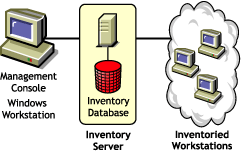
The following sections contain detailed information to help you deploy Workstation Inventory in a single site:
Deployment Options for Inventory Agent
Before installing the Inventory Agent on your workstation, you must deploy the Inventory servers to receive workstation scans. For more information about the deployment options for Inventory Agent, see Deploying the Inventory Agent.
Recommendations for Deployment
-
The minimum base Inventory server configuration includes 512 MB RAM and a database cache of 128 MB.
-
The transmission of inventory information to the Inventory server and storage of the inventory information into the Inventory database is an ongoing back end process that can take several hours or even more than a day.
-
If many inventoried workstations are attached to the same Inventory server, we recommend that you do not schedule the scan of all inventoried workstations at the same time, because this stresses Novell eDirectory™ and the Inventory services.
-
Make sure that the eDirectory time synchronization radius is set within 2 seconds.
-
The optimal database cache size requirement for the server could vary because of the server environment. Determine the database cache size that needs to be set by trying a range of cache sizes in the runtime environment. The default Sybase database cache size is 128 MB. For more information about improving the database performance, see Section M.0, Performance Tips.
Installing Workstation Inventory
During the Workstation Inventory installation, configure the Inventory Standalone Configuration settings. For detailed information, see the Novell ZENworks 7 Desktop Management Installation Guide.
Understanding the Effects of Workstation Inventory Installation
For detailed information on the effects of Workstation Inventory installation, see Section 73.1.4, Understanding the Effects of Workstation Inventory Installation.
Configuring the Required Policy
Configure the Workstation Inventory Policy.
Starting the Inventory Service
After installing ZENworks 7 Desktop Management, the Inventory service is automatically started.
Updating the Software Dictionary
You must manually download the latest version of the dictionary from TID 10093255 in the Novell Support Knowledgebase and update the software dictionary.
NOTE:The dictionary is updated and published once in every three months in this TID.
Understanding the Inventory Scanning Cycle in the Standalone Scenario with Novell Client Installed on Inventoried Workstations
The inventory scanning cycle is as follows:
-
The Inventory policies in eDirectory define the inventory settings, such as scanning time and the location of the scan directory. These settings can be customized.
-
The scanner reads the inventory policies and collects the workstation inventory information. The Inventory scanner also checks whether an updated dictionary is available at its Inventory server and downloads the updated dictionary.
-
The scanner stores the inventory information of each inventoried workstation at the Inventory server.
-
The scanner stores the minimal inventory information of the inventoried workstation in the respective workstation objects in the eDirectory.
-
The Selector validates the inventory information and places the information in the Inventory database.
-
The Storer updates the database with the inventory information.
-
The ZENworks administrator views the inventory information.
The following illustrations depict the inventory scanning cycle in the Standalone scenario with Novell Client installed.
Figure 73-2 Inventory Scanning cycle in the Standalone scenario with Novell Client installed
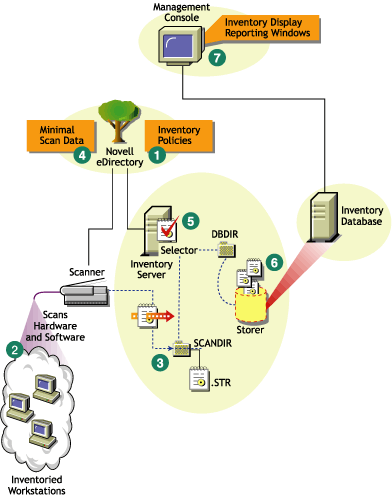
73.1.2 Advanced Deployment
Deploying Inventory in a Single Site with More than 5,000 Inventoried Workstations
In this example scenario, the network consists of a single site with more than 5000 workstations. The inventory configuration consists of two or more Standalone Servers, each server receiving scans from up to 5,000 inventoried workstations. All the Standalone Servers store the inventory data to a single database.
The following sections contain detailed information to help you deploy Workstation Inventory on a single site:
Deployment Options for Inventory Agent
Before installing the Inventory Agent on your workstation, you must deploy the Inventory servers to receive inventory scans. For more information about the deployment options for Inventory Agent, see Deploying the Inventory Agent.
Recommendations for Deployment
-
The minimum base Inventory server configuration includes 512 MB RAM and a database cache of 128 MB.
-
All inventoried workstations should send the inventory information to the nearest Inventory server on the LAN; policies must be created based on this information.
-
The transmission of inventory information to the Inventory server and storage of the inventory information into the Inventory database is an ongoing back end process that can take several hours or even more than a day.
-
If many inventoried workstations are attached to the same Inventory server, we recommend that you do not schedule the scan of all inventoried workstations at the same time, because this stresses Novell eDirectory™ and the Inventory services.
-
Make sure that the eDirectory time synchronization radius is set within 2 seconds.
-
The optimal database cache size requirement for the server could vary because of the server environment. Determine the database cache size that needs to be set by trying a range of cache sizes in the runtime environment. The default Sybase database cache size is 128 MB. For more information about improving the database performance, see Section M.0, Performance Tips.
Installing Workstation Inventory
During the Workstation Inventory installation, configure the Inventory Standalone Configuration settings. For detail information on installing Workstation Inventory, see Novell ZENworks 7 Desktop Management Installation Guide.
Understanding the Effects of Workstation Inventory Installation
For detail information on the effects of Workstation Inventory installation, see Section 73.1.4, Understanding the Effects of Workstation Inventory Installation.
Configuring the Required Policy
Configure the Workstation Inventory Policy.
Starting the Inventory Service
After installing ZENworks 7 Desktop Management, the Inventory service is automatically started.
Updating the Software Dictionary
You can update the software dictionary in any one of the following ways:
-
On each Inventory server, manually download the latest version of the dictionary from TID 10093255 in the Novell Support Knowledgebase and update the software dictionary.
-
Manually download the latest version of the dictionary from TID 10093255 in the Novell Support Knowledgebase on one of the Standalone Servers and automatically distribute the dictionary from this server to all other Standalone Servers in your setup by Configuring the Dictionary Update Policy. For more information, see Section 73.9, Setting Up Distribution of Dictionary.
NOTE:The dictionary is updated and published once in every three months in this TID.
Understanding the Inventory Scanning Cycle in the Standalone Scenario
The inventory scanning cycle is as follows:
-
The Inventory policies in eDirectory define the inventory settings, such as scanning time and the location of the scan directory. These settings can be customized.
-
The scanner reads the inventory policies and collects the workstation inventory information. The Inventory scanner also checks whether an updated dictionary is available at its Inventory server and downloads the updated dictionary.
If the Novell Client is not installed on the inventoried workstation, the Scanner accesses eDirectory through the ZENworks 7 Desktop Management Middle Tier Server.
-
The scanner stores the inventory information of each inventoried workstation at the Inventory server.
If the Novell Client is not installed on the inventoried workstation, the Scanner sends the inventory information of each inventoried workstation to the Inventory server through the ZENworks 7 Desktop Management Middle Tier Server.
-
The scanner stores the minimal inventory information of the inventoried workstation in the respective workstation objects in the eDirectory.
If the Novell Client is not installed on the inventoried workstation, the Scanner accesses eDirectory through the ZENworks 7 Desktop Management Middle Tier Server.
-
The Selector validates the inventory information and places the information in the Inventory database.
-
The Storer updates the database with the inventory information.
-
The ZENworks administrator views the inventory information.
The following illustrations depict the inventory scanning cycle in the Standalone scenario, both with and without the Novell Client installed.
Figure 73-3 Inventory Scanning Cycle in the Standalone scenario with the Novell Client installed

Figure 73-4 Inventory Scanning Cycle in the Standalone Server without the Novell Client installed
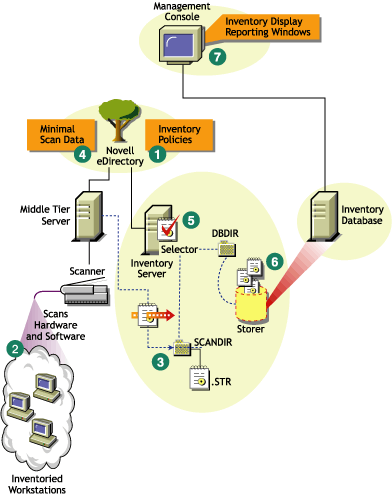
Deploying Inventory in Multiple or Enterprise Sites
The following sections contain detailed information to help you deploy Workstation Inventory in multiple or enterprise sites:
Designing the Inventory Tree
In an enterprise or multiple site, complete the following tasks to design the inventory tree:
1. List the sites in the enterprise
Describe the entire network of your enterprise.
-
List the various sites in your enterprise.
-
List the physical links between the various sites.
-
Identify the type of links in terms of bandwidth and reliability.
The following figure illustrates the network organization of an enterprise with servers in different locations.
Figure 73-5 Network organization of an enterprise
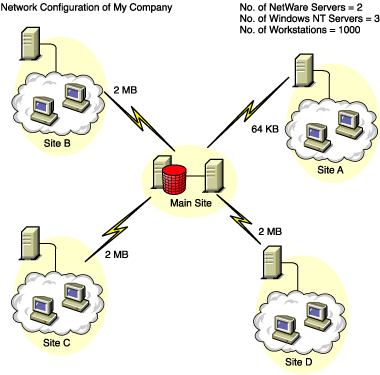

This illustration depicts four sites (Site A, Site, B, Site C, and Site D) connected to a central site. It depicts the physical links between the sites and the type of links in terms of bandwidth.
2. What is the ideal place for the Root Server?
The Root Server in the inventory tree is the highest-level server. Necessarily, an Inventory database is attached to the Root Server.
The inventory information available from the Inventory database of the Root Server consists of all information from lower-level sites on the network and from the Root Server site.
Factors that you must consider include:
-
There must be high-speed links between the Root Server and the management console.
-
We recommend that there should be high-speed links between the site having the Root Server and the sites having the lower-level Inventory servers.
-
Using the management console, the administrator can collect the inventory information from any of the sites connected on high-speed links from the Root Server, or from the Root Server level site.
-
A database server of suitable configuration should be provided for the Inventory server.
3. Is any other database needed?
In addition to the database at the Root Server, you can maintain database servers at different sites.
You might want to maintain additional databases if there are sites or subtrees that are managed for inventory at different locations, and these sites are connected to the network over a slow link.
You should also determine if there are specific reasons to have a separate database for a single site or a set of sites. There might be some organizational needs for your enterprise to have the database server on different sites, even if there is no product deployment need to have any other database.
NOTE:For a majority of enterprises, there could be no need to have any other database besides the enterprise-wide single database.
Optional step: If another database is needed
-
If you decide to have additional database servers, identify the sites that need a database. Additionally, you need to examine whether the database caters to the local site or a site with many subsites. Also, identify the sites that require information in each Inventory database.
-
All the sites served by a single database should typically access this database instead of the database at the Root Server for inventory management. This reduces the load on the database at Root Server.
-
Database administrators should be available for these sites.
4. Identify the route for Inventory information
Identify the routes for inventory information for all Inventory servers to the nearest database.
To devise a route plan:
-
Each route can have an Intermediate Server at a staging site. The Intermediate Server receives and transmits the information to the next destination. These are application-layer-level routes for inventory information. There can be various network-layer-level routes between two adjacent servers, which is determined and managed by the routers in the network.
-
The route provides information indicating how inventory information travels from a particular site to its final destination, which is the database at the Root Server.
-
There can be multiple routes. Choose the fastest and most reliable route. To determine the route, consider the physical network links.
-
Routes identified and made operational can be changed later, although there might be some cost in terms of management and traffic generation. If there is no intermediate database involved, you can change the route by changing the eDirectory-based policy.
-
Put Intermediate Servers on sites where the link parameters change substantially. Criteria to consider are difference in bandwidth, difference in reliability of the links, and the need for roll up of inventory information.
-
Availability of Inventory servers on the intermediate site for staging the inventory information should be considered while deciding the sites for Intermediate Servers. Make sure that there is enough disk space on these servers to store all the inventory information on the disk until the Sender sends it to the next destination.
5. Identify servers on each site to act as Inventory and Database Servers
In ZENworks 7 Desktop Management, you choose the role for each Inventory server. For more information, see Section 72.4, Understanding the Inventory Server Roles.
The number of inventoried workstations attached to an Inventory server also determines the load. The following table lists the disk space requirements for the server:
Table 73-1 Disk Requirements for a ZENworks Inventory Server
|
Server Type |
Disk Space Requirements |
|---|---|
|
Leaf Server |
(n1 x s) + (n1 x z) |
|
Leaf Server with Database |
(n1 x s x 2) + {(n1 x dbg)} |
|
Intermediate Server |
n2 x z |
|
Intermediate Server with Database |
(n2 x z) + (n2 x s) + {(n2 x dbg)} |
|
Intermediate Server with Inventoried Workstations |
(n1 x s x 2) + (n2 x z) |
|
Intermediate Server with Database and Inventoried Workstations |
(n1 x s x 2) + (n2 x z) + (n2 x s) + {(n1 x dbg) + (n2 x dbg)} |
|
Root Server |
(n2 x z) + (n2 x s) + {(n2 x dbg)} |
|
Root Server with Inventoried Workstations |
(n1 x s x 2) + (n2 x z) + (n2 x s) + {(n1 x dbg) + (n2 x dbg)} |
|
Standalone Server |
(n1 x s x 1) + {(n1 x dbg)} |
In the table, n1 is the number of inventoried workstations attached to the server.
s is the size of the scan data files. This file size varies depending on the data collected. Calculate 400 KB scan data from each inventoried workstation to calculate the load.
dbg is the storage space of the inventory information in the database.
n2 is the number of inventoried workstations rolled up to the Inventory server.
z is the size of the compressed scan data file per inventoried workstation. The average compression ratio is 80-90% of the STR file size.
{ } denotes the disk space of the database server, depending on whether the database is on the same Inventory server or if it is connected to the Inventory server. If the database is on the same Inventory server, calculate the total disk space including the database space for the Inventory server. For example, if the Leaf Server with Database has the Inventory database on the same server, calculate the requirements for storage of inventory information, including the database disk space.
6. Create the tree of servers for enterprise Inventory collection
Make sure that the inventory tree you design follows these guidelines:
-
The root of the tree is the Root Server.
-
At least one Inventory server per site is recommended.
-
Each site has inventoried workstations to be scanned.
-
Optionally, there are databases and Intermediate Servers on different sites.
7. Create an implementation plan
After you design the inventory tree, you should develop an implementation plan to cover the phased deployment plan for the network. Use the top-down deployment of the Workstation Inventory installation. Always begin the installation at the topmost level server (Root Server) and proceed with the next lower-level servers.
8. Start the actual deployment
After your implementation plan is finalized, start the actual deployment according to the plan.
Follow these steps:
-
Install the Inventory servers on the sites. For more information, see Installing Workstation Inventory.
-
Create and configure the policies applicable to Inventory server and inventoried workstations. For more information, see Configuring the Required Policies.
Adding a Database Server to an Existing Inventory Setup
If you have already configured the servers for inventory setup, and you need to add another database server, follow these instructions:
-
Run the installation program to install the Inventory database on the server.
The installation program installs the Sybase database. If you are maintaining the database in Oracle, make sure that the Oracle database exists. For more information, see Setting Up the Sybase Inventory Database. If you are maintaining the database in MS SQL, make sure that the MS SQL database exists. For more information, see Setting Up the MS SQL Server 2000 or MS SQL Server 2005 Inventory Database
-
Shut down the Inventory services. For more information, see Section 73.1.5, Starting and Stopping the Inventory Service.
-
Based on the database you select, make sure that you configure the database. For more information, see Section 73.5, Configuring the Database Location Policy.
-
If you want to attach a new database to an existing Inventory server that does not have a database attached, you must change the role of the Inventory server in its Inventory Service object (Inventory Service_server_name). For example, if you attach an Inventory database to an existing Leaf Server, you must change the server role from Leaf Server to Leaf Server with Database in the Inventory Service object of the Leaf Server.
If you want to attach an Inventory database to a freshly installed Inventory server, you must choose an appropriate server role for the Inventory server.
To change the role of an Inventory server:
-
In ConsoleOne, right-click the Inventory Service object, click , then click the tab.
-
Choose the new role of the Inventory Service object, then click .
Follow the actions that you need to change the role. For more information, see Section 73.1.7, Changing the Role of the Inventory Server.
-
-
-
Make sure that you enforce Full Scan for the Inventory Service object.
-
In ConsoleOne, right-click the Inventory Service object, click , then click the tab.
-
Select the , then click .
-
-
Bring up the Inventory service. For more information, see Section 73.1.5, Starting and Stopping the Inventory Service.
Deployment Options for Inventory Server and Inventory Database
This section covers these scenarios:
Scenario 1: Inventory Deployment without Intermediate Servers in a WAN
In this scenario, the network consists of many remote sites connected to a Central Site over a WAN. Each remote site has a Leaf Server that collects inventory information from workstations located in the same site, and rolls up the inventory information to the Root Server located at the central site. The remote sites are administered from the Central Site because the Leaf Servers do have Inventory database attached to it.
HINT:To locally administer the remote sites, you must have the Inventory database attached to Leaf Servers and change the role of the Inventory server to Leaf Server with Database. For more information on how to change the role of an Inventory server, see Section 73.1.7, Changing the Role of the Inventory Server.
This scenario is illustrated in the following figure.
Figure 73-6 Inventory Deployment without Intermediate Servers in a WAN
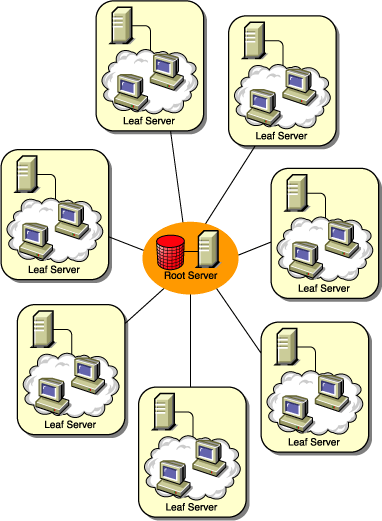
Scenario 2: Inventory Deployment with Intermediate Servers in a WAN
In this scenario, the network consists of four remote sites (A, B, C, and D), and a Central Site. Sites A and B are connected to Site C over slow links and are not directly connected to the Central Site. Site C is connected to the Central Site over a fast WAN link. Site D is directly connected to the Central Site over a fast link. Sites A, B and C are administered at Site C.
This scenario is illustrated in the following figure.
Figure 73-7 Inventory Deployment with Intermediate Servers in a WAN
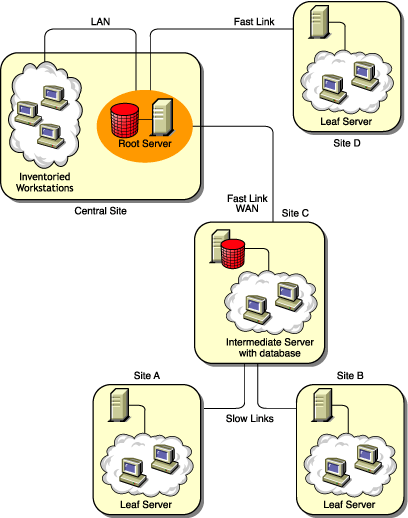

To administer the enterprise from the Central Site, and also administer Sites A and B from Site C, do the following:
-
Install Leaf Servers at Sites A, B, and D.
-
Install Intermediate Servers with Database at Site C.
-
Configure Leaf Servers at Sites A and B to roll up the inventory information to the Intermediate Server with Database at Site C.
-
Configure the Intermediate Server with Database at Site C to roll up the inventory information to Root Server at the Central Site.
-
Configure the Leaf Server at Site D to roll up the inventory information to Root Server at the Central Site.
Scenario 3: Roll Up of the Inventory Information Across eDirectory Trees
In this configuration, you can deploy any of the previous scenarios. The highest-level Inventory server of one eDirectory tree rolls up the inventory information to an Inventory server located on the other eDirectory tree.
The following illustration depicts a sample scenario where you can deploy this inventory configuration.
Figure 73-8 Roll Up of the Inventory Information across eDirectory Trees
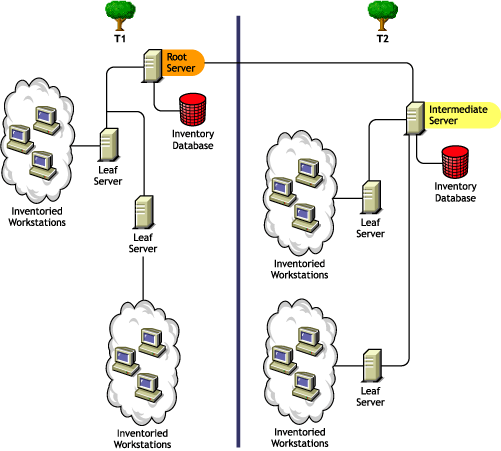
There are two organizations: A and B. Each organization has its own eDirectory tree and inventory tree. Organization A has two Leaf Servers and a Root Server in its inventory tree. Organization B also has two Leaf Servers and a Root Server in its inventory tree. A decision is taken to merge both the organizations and both the inventory trees but to retain the eDirectory trees. After the merger, the role of the Root Server on the eDirectory tree T2 is changed to Intermediate Server with Database and the inventory information is rolled up from the Intermediate Server to the Root Server residing on the eDirectory tree T1.
Scenario 4: Merging eDirectory Trees
In this configuration, you can merge the inventory trees and the eDirectory trees. After you merge the eDirectory trees, you must manually change the eDirectory tree name and (optionally) the Inventory Service DN in the Inventory_server_installation_drive or volume\zenworks\inv\server\wminv\properties\config.properties file before starting the Inventory service. For more information on merging the eDirectory trees, see the Novell eDirectory documentation Web site.
To merge the inventory trees, you must change the role of the Root Server of one inventory tree to roll up to an Inventory server in the other inventory tree.
To change the eDirectory tree name and the DN of an Inventory server, edit the following entries of the config.properties file:
NDSTree=Target_eDirectory_tree_name
InventoryServiceDN=New_DN_of_the_Inventory_server
Scenario 5: Deploying Inventory Server Across a Firewall
There are two sites; Site A and Site B connected through a WAN link. The Inventory server of Site A rolls up to an Inventory server in Site B. All communication from Site A to Site B flows through the firewall at Site B.
The following illustration depicts a sample scenario where you can deploy this inventory configuration:
Figure 73-9 Deploying Inventory Server across a Firewall
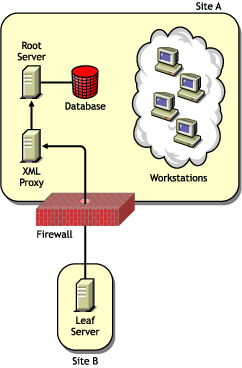
To enable the roll-up:
-
Install an XML proxy at Site A. For more information about installing the proxy, see the Novell ZENworks 7 Desktop Management Installation Guide.
-
You must have at least one XML proxy/site installed. One proxy server can handle requests for multiple Inventory servers.
-
You can configure the port that the proxy listens to during the ZENworks 7 Desktop Management installation. For more information, see the Novell ZENworks 7 Desktop Management Installation Guide.
You must allow requests to the proxy server on this port at the firewall. You can configure the XML proxy to listen to standard ports allowed by your firewall.
The XML proxy does not support any commercial Web server. You must make sure that the port number assigned to the XML proxy is not used by any other service on the same server.
You must also configure the Roll-Up policy with the XML proxy server's address and port number.
Deployment Options for Inventory Agent
Before installing the Inventory Agent on you workstation, you must deploy the Inventory servers to receive workstation scans. For more information about the deployment options for Inventory Agent, see Deploying the Inventory Agent.
Recommendations for Deployment
-
When you configure the inventory scanning of inventoried workstations, we recommend staggering the inventory scanning to scan at different times or to scan a group of inventoried workstations at a time.
-
If many inventoried workstations are attached to the same Inventory server, we recommend that you do not schedule the scan of all inventoried workstations at the same time, because this stresses eDirectory and the Inventory service.
-
You can attach inventoried workstations to the server as determined by the number of connections supported by Inventory servers up to a maximum of 5,000 inventoried workstations.
-
When you schedule the roll-up of information in the Inventory policies, we recommend the roll-up frequency should be at least one day. If the roll-up of inventory information is scheduled too frequently, for example less than one hour, there might be some performance degradation of the Inventory server.
-
Use top-down deployment for Inventory installation. Always begin the installation at the topmost level server and proceed with the next lower-level servers. For example, in an inventory setup with a Root Server and a Leaf Server, complete the inventory installation at the Root Server, and then run the installation for the Leaf Server.
-
If an Inventory server must receive Inventory scans either directly from the Inventory servers or through roll-up, you must install ZENworks 7 Desktop Management on this server.
-
We recommend that you configure DNS for your Inventory and database servers. If you have not configured DNS, choose the IP address in the Roll-Up and Database Location policies. Scheduling the frequency of information gathering and roll-up must be fine-tuned based on the Root Server. Make sure that the Root Server is able to handle the load of the .str files.
Installing Workstation Inventory
For detailed information on installing Workstation Inventory, see the Novell ZENworks 7 Desktop Management Installation Guide.
Understanding the Effects of Workstation Inventory Installation
For detailed information on the effects of Workstation Inventory installation, see Section 73.1.4, Understanding the Effects of Workstation Inventory Installation.
Configuring the Required Policies
The following table lists the actions that you should follow to set up the server for Workstation Inventory:
Table 73-2 Policies Required to set up an Inventory Server
Starting the Inventory Service
After installing ZENworks 7 Desktop Management, the Inventory service is automatically started only if you have configured the Inventory Standalone Configuration settings during the installation.
To manually start the Inventory service, see Section 73.1.5, Starting and Stopping the Inventory Service.
Updating the Software Dictionary
You can update the software dictionary in any one of the following ways:
-
On each Inventory server, manually download the latest version of the dictionary from TID 10093255 in the Novell Support Knowledgebase and update the software dictionary.
-
Manually download the latest version of the dictionary from TID 10093255 in the Novell Support Knowledgebase on an Inventory server (preferably, the Root Server) and automatically distribute the dictionary to all servers in your setup by configuring the Section 73.8, Configuring the Dictionary Update Policy. For more information, see Section 73.9, Setting Up Distribution of Dictionary.
NOTE:The dictionary is updated and published once in every three months in this TID.
Understanding Rolling Up Inventory Information Across Servers
If the inventory deployment rolls up inventory information across servers, the process of scanning is as follows:
-
The Inventory policies in eDirectory define the inventory settings, such as scanning time and the location of the scan directory. These settings can be customized.
-
The Scanner reads the Inventory policies and collects the workstation inventory information. The Inventory scanner also checks whether an updated dictionary is available at its Inventory server and downloads the updated dictionary.
If the Novell Client is not installed on the inventoried workstation, the Scanner accesses eDirectory through the ZENworks 7 Desktop Management Middle Tier Server.
-
The Scanner stores the inventory information of each inventoried workstation as a scan data file in the scan directory at the Inventory server.
If the Novell Client is not installed on the inventoried workstation, the Scanner sends the inventory information of each inventoried workstation to the Inventory server through the ZENworks 7 Desktop Management Middle Tier Server.
-
The Scanner stores the minimal inventory information of the inventoried workstation in the respective workstation objects in the respective workstation objects in eDirectory.
If the Novell Client is not installed on the inventoried workstation, the Scanner accesses eDirectory through the ZENworks 7 Desktop Management Middle Tier Server.
-
The Selector validates the .str file and places the file in the enterprise merge directory for roll-up of inventory information. If there is a database attached, the Selector places the files in the database directory also.
-
The Sender on the server has a Roll-Up policy to identify the server to which it transmits the inventory information and the Roll-Up Schedule specifies a time for roll-up of information. The Sender compresses the .str files as a .zip file and places the .zip file in the enterprise push directory (entpushdir). The Sender then sends the .zip file to the Receiver on the next-level server.
-
The Receiver on the next-level server receives the .zip file.
NOTE:The next-level Inventory server can be located on the same eDirectory tree or on a different eDirectory tree or across firewalls.
On the Intermediate Server, the Receiver copies the file in the enterprise push directory. On the Intermediate Server with Database, or the Intermediate Server with Database and Inventoried Workstations, the Receiver copies the file in entpushdir and copies the file in the Database Directory.
On the Root Server, or the Root Server with Inventoried Workstations, the Receiver copies the file in dbdir only.
-
The Storer extracts the .zip file containing the .str files in to a temp directory (dbdir\temp) and updates the database with the inventory information of the inventoried workstation .str file.
-
The ZENworks administrator views the inventory information, queries the database, generates inventory reports, and performs other Inventory based tasks in ConsoleOne.
The following illustrations depict the inventory scanning cycle in the Roll-Up scenario, both with and without the Novell Client installed.
Figure 73-10 Inventory scanning cycle in the Roll-Up scenario with the Novell Client installed
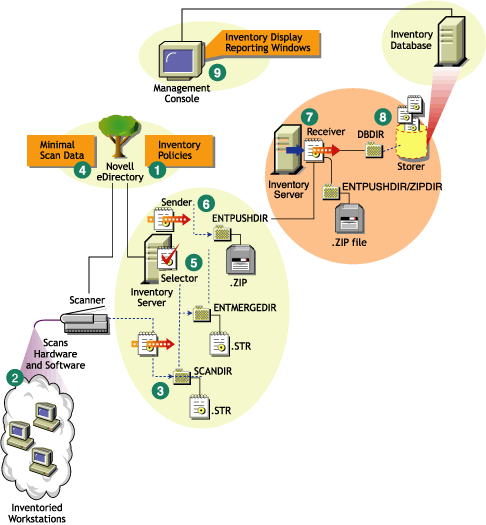
Figure 73-11 Inventory scanning cycle in the Roll-Up scenario without the Novell Client installed
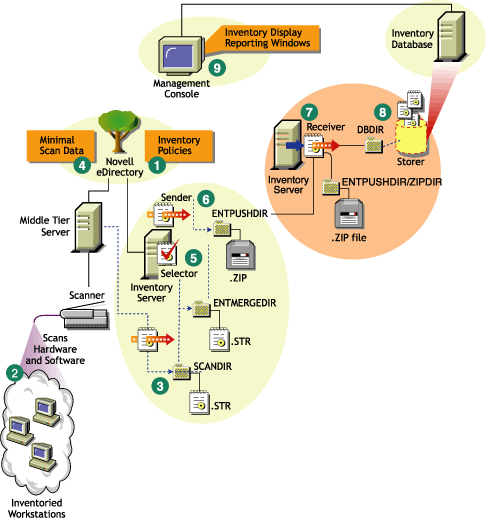
73.1.3 Deploying the Inventory Agent
Before installing the Inventory Agent on your workstations, you must deploy the Inventory servers to receive workstation scans.
IMPORTANT:Before deploying Inventory Agent, we recommend that you customize your software scan rules to create a base-line configuration. For more information, see Section 76.2, Customizing the Hardware Inventory Information To Be Scanned.
You can deploy the Inventory Agent in the following scenarios:
Scenario 1: Deploying the Inventory Agent on Workstations that are in the Same LAN as the Inventory Server
In this scenario, the inventoried workstations and the Inventory server are in the same LAN environment.
-
If the Novell Client is installed on inventoried workstations or if you plan to install the Novell Client on inventoried workstations before installing the ZENworks 7 Desktop Management - Inventory Agent:
-
Install the ZENworks 7 Desktop Management Inventory Agent on inventoried workstations. For more information, see the Novell ZENworks 7 Desktop Management Installation Guide.
The Inventory Agent directly sends the scans to the Inventory server.
-
You can configure a maximum of 5000 inventoried workstations to send scans to an Inventory server.
-
-
If the Novell Client is not installed on inventoried workstations or if you do not plan to install the Novell Client on inventoried workstations before installing the ZENworks 7 Desktop Management Inventory Agent:
-
Install the ZENworks 7 Desktop Management Inventory Agent, which works in the clientless mode. The Inventory Agent routes the requests through the Middle Tier. For more information, see the Novell ZENworks 7 Desktop Management Installation Guide.
-
You must have one ZENworks 7 Desktop Management Middle Tier Server for each site. For more information, see the Novell ZENworks 7 Desktop Management Installation Guide.
-
You can configure a maximum of 5000 workstations to send scans to an Inventory server.
-
Scenario 2: Deploying the Inventory Agent on Workstations that Send Scans over a WAN across the Firewall
Consider a scenario where there are two sites, A and B, that are connected via a WAN link. All communication from Site B to Site A goes through the firewall at Site A. Site B has five workstations with the Inventory Agent installed, and they do not have the Novell Client installed. The five workstations must be inventoried and the scan must be sent directly to the Inventory server at Site A. You must install the Middle Tier Server at Site A. For more information, see the Novell ZENworks 7 Desktop Management Installation Guide. Site B must be connected to Site A through a fast WAN link. This should have sufficient bandwidth to handle traffic generated by the workstations when accessing policies in the eDirectory and sending scans to the Inventory server.
The following illustration depicts a sample scenario where you can deploy this inventory configuration
Figure 73-12 Deploying the Inventory Agent on Workstations that send scans over a WAN across the Firewall
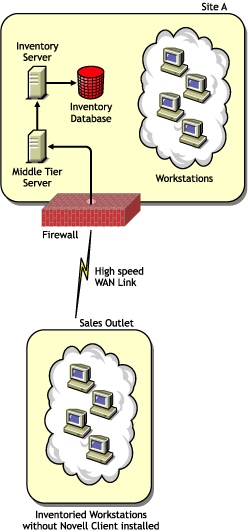
Scenario 3: Deploying Inventory Agent on Workstations that Are Periodically Connected to the Network
In this scenario, the Inventory Agent is installed on workstations that periodically connect to the network.
The inventoried workstations are connected periodically to the network. The workstation policies are refreshed when the inventoried workstation connects to the network. If the scan schedule expires, the Inventory Agent defers scanning the inventoried workstation until the workstation is connected to the network.
We recommend that you set your scan schedule to match when the inventoried workstation connects to the network.
For more information, see Section 76.5, Scanning for Workstations That Are Periodically Connected to the Network.
Scenario 4: Deploying Inventory Agent on Workstations that Are Never Connected to the Network
In this scenario, the Inventory Agent is installed on workstations that are never connected to the network. For more information, see Collecting Inventory for Workstations That Are Not Connected to the Network.
73.1.4 Understanding the Effects of Workstation Inventory Installation
On the Inventory servers, the Workstation Inventory installation program does the following:
On NetWare Inventory Servers
-
Copies the Workstation Inventory related files to the installation_volume.
-
Copies the Workstation Inventory snap-ins to the ConsoleOne® directory.
-
Creates an Inventory Service object (Inventory Service_server_name) in eDirectory for each server on which Inventory server is installed. This object is populated with the following attributes: zeninvRole (role of the server), zeninvScanFilePath (path to the scandir directory), zeninvHostServer (DN of the server on which Inventory server is installed), and zeninvDictionarypath (Path to the dictionary directory).
-
If the Inventory Service object already exists, the object is validated and re-created again if it is invalid.
-
During installation, the Inventory Service object is made a trustee of the NCP™ server with Compare and Read rights.
-
Assigns the Inventory Service object as trustee to itself.
-
Creates the scan directory with the subdirectories in the specified volume on the Inventory server. [Root] is granted the Create rights to this directory.
-
Creates a dictionary directory (dictdir), and copies the files of general dictionary and private dictionary. [Root] is granted the Read and Write rights to this directory.
-
Creates the zenworks.properties file in sys:\system. This file contains the installation path of the Inventory server and the ZEN Web server.
-
During the Workstation Inventory installation, if you have configured Inventory Standalone Configuration settings, then the Inventory Service Manager is automatically started.
-
Installs the ZEN Web server on the Inventory server, if it is not installed already.
-
If Workstation Inventory is reinstalled in the same directory as the previous installation, the config.properties and directory.properties files are backed up and re-created.
On Windows Inventory Servers
-
Copies the Workstation Inventory related files to the installation_directory.
-
Copies the Workstation Inventory snap-in component to the ConsoleOne directory.
-
Creates the scan directory with the subdirectories in the specified directory on the Inventory server, and creates a share with Create rights to this directory for all users.
-
Creates a dictionary directory (dictdir), copies the files of general dictionary and private dictionary, and grants Read and Write rights to this directory for all users.
-
Creates an Inventory Service object (Inventory Service_server_name) in eDirectory for each server on which Inventory server is installed. This object is populated with the following attributes: zeninvRole (role of the server), zeninvScanFilePath (path to the scandir directory), zeninvHostServer (DN of the server on which Inventory server is installed) and zeninvDictionarypath (Path to the dictionary directory).
-
If the Inventory Service object (Inventory Service_server_name) already exists, the object is validated and re-created again if it is invalid.
-
During installation, the Inventory Service object is made a trustee of the NCP server with Compare and Read rights.
-
Assigns the Inventory Service object as trustee to itself.
-
The Inventory Service Manager is created as a service.
-
Edits the Registry settings to add the installation path of the Inventory server and the ZEN Web server.
-
On the Inventory server, the ZENworks Service Management is created as a service.
-
If the Workstation Inventory is reinstalled in the previous installation directory, the config.properties and directory.properties files are backed up and re-created.
On Linux Inventory Servers
-
Copies the Workstation Inventory related files through the novell-zenworks-invserver and novell-zenworks-invrmcommon RPMs.
-
Creates an inventory user in the inventory and zenworks groups.
-
Creates a a scan directory (/opt/novell/zenworks/inv/ScanDir) with the subdirectories, assigns read and execute permissions for all the directories in the path of ScanDir and creates a samba share with Create rights to this directory for all users.
-
Creates a dictionary directory (/opt/novell/zenworks/inv/server/DictDir), copies the files of general directory and private dictionary, and grants Read and Write rights to this for all users.
-
Creates an Inventory Service object (Inventory Service_server_name) in eDirectory for each server on which Inventory server is installed. This object is populated with the following attributes: zeninvRole (role of the server), zeninvScanFilePath (path to the scandir directory), zeninvHostServer (DN of the server on which Inventory server is installed) and zeninvDictionarypath (Path to the dictionary directory).
-
Creates the NCP shares for the ScanDir and DictDir volumes of OES.
-
Creates the Inventory server as a daemon in /etc/init.d/novell-zdm-inv, and adds it to be started when the server boots.
On Database Servers
-
Installs the Sybase database on the server you specify.
-
At server startup time, the database is loaded.
-
On NetWare, the mgmtdb.db entries are added to the sys:\system\mgmtdbs.ncf file. On Windows, the mgmtdb.db entries are added to the registry.
-
Creates two database objects (Inventory database_server_name and Desktop Management database_server_name_) for Sybase and configures the properties of the object.
-
If the database server is installed in the previous installation directory, the database files are re-created if they were found invalid or non-existing.
-
If Sybase is already installed, only the database files are copied.
73.1.5 Starting and Stopping the Inventory Service
The section provides information on:
For more information about the various Inventory services, see Section 74.1, Understanding the Inventory Service Manager.
Starting the Inventory Service on a NetWare Inventory Server
Before you start the Inventory service, make sure that the Inventory database is up and running. The Inventory database is automatically started after the installation.
To start the Inventory service on the NetWare Inventory server, enter startinv at the server console prompt.
To start an Inventory service, enter startser inventory_service_name at the server console prompt. For more information about different Inventory services, see List of Services.
After starting the Inventory service, make sure that the Inventory services are up and running. To list all services, enter listser * at the server console prompt. To list an Inventory service, enter listser inventory_service_name at the server console prompt.
If the services are not up and running, check the Server Status log. For more information on the Server Status log, see Section 78.4, Viewing the Status of Inventory Components on a Server.
Stopping the Inventory Service on a NetWare Inventory Server
To stop an Inventory service, enter stopser Inventory_service_name at the server console prompt.
To stop all the Inventory services, enter stopser * at the server console prompt.
Starting the Inventory Service on a Windows Inventory Server
Before you start the Inventory service, make sure that the Inventory database is up and running. The Inventory database is automatically started after the installation.
To start the Inventory services on the Windows 2000/2003 Inventory server:
-
In the Control Panel, double-click Administrative Tools.
-
Double-click Services.
-
Select Novell Inventory Service, then click Start.
To start an Inventory service from the console prompt:
-
Go to the installation_directory\inv\server\wminv\bin directory.
-
At the prompt, enter startser inventory_service_name.
After starting the Inventory service, make sure that the Inventory services are up and running. To list all services, enter listser “*” at the server console prompt. To list an Inventory service from the console prompt:
-
Go to the installation_directory\inv\server\wminv\bin directory.
-
At the prompt, enter listser inventory_service_name.
If the services are not up and running, check the Server Status log. For more information on the Server Status log, see Section 78.4, Viewing the Status of Inventory Components on a Server.
Stopping the Inventory Service on a Windows Inventory Server
To stop the Inventory services on a Windows 2000/2003 Inventory server:
-
In the Control Panel, double-click Administrative Tools.
-
Double-click Services.
-
Select Novell Inventory Service, then click Stop.
To stop an Inventory service on a Windows Inventory server from the console prompt:
-
Go to the installation_directory\inv\server\wminv\bin directory.
-
Enter stopser inventory_service_name.
Starting the Inventory Service on a Linux Inventory Server
-
To start all Inventory services, do any of the following ways:
- 1. At the Linux server prompt, go to /etc/init.d.
- 2. Enter ./novell-zdm-inv start.
Or
To start all Inventory services from any directory on Linux, enter
/etc/init.d/novell-zdm-inv start
-
To start a specific Inventory service:
- 1. At the Linux server prompt, go to /opt/novell/bin.
- 2. Enter StartSer Inventory_service.
Stopping the Inventory Service on a Linux Inventory Server
-
To stop all Inventory services, do any of the following ways:
- 1. At the Linux server prompt, go to /etc/init.d.
- 2. Enter ./novell-zdm-inv stop.
Or
To stop all Inventory services from any directory on Linux, enter
/etc/init.d/novell-zdm-inv stop
-
To stop a specific Inventory service:
- 1. At the Linux server prompt, go to /opt/novell/bin.
- 2. Enter StopSer Inventory_service.
73.1.6 Checking the Status of the Workstation Inventory Components Installed on Linux
The following table lists the Workstation Inventory components installed on Linux whose status you can check by executing commands at the Linux console prompt.
Table 73-3 Commands to check the status of Workstation Inventory components installed on Linux
|
Workstation Inventory Component |
Command To Be Entered At the Linux Console Prompt |
|---|---|
|
Inventory server daemon |
/etc/init.d/novell-zdm-inv status |
|
Sybase daemon |
/etc/init.d/novell-zdm-sybase status |
|
Inventory Proxy daemon |
/etc/init.d/novell-zen-zws status |
73.1.7 Changing the Role of the Inventory Server
When you install ZENworks 7 Desktop Management, by default, the role of the Inventory server is that of a Standalone. By configuring the Inventory Service object, you can assign specific roles to the Inventory server based on your inventory deployment.
For example, if the deployment plan identifies three servers, such as a Root Server, an Intermediate Server with Database, and a Leaf Server for inventory deployment, you install Workstation Inventory on these servers, and choose the role for the server. Later, if you want to make changes in the inventory deployment, such as attaching the inventoried workstations to the existing Root Server, you need to change the role of the Inventory Service object from Root Server to Root Server with Inventoried Workstations. Additionally, depending on the new role, there are some policies you need to configure.
To change the role for any Inventory server:
-
Plan the change of roles carefully because the changes impact the existing inventory deployment. Also, consider the disk space requirements and make sure that you have the required configurations for Inventory.
-
In ConsoleOne, right-click the Inventory Service object (Inventory Service_server_name), click , then click the tab.
-
Choose the new role of the Inventory Service object, then click .
-
Bring down the services running on the changed server, follow the actions that you need to change the role, and then bring up the server.
For detailed information about how to stop and restart the Inventory service, see Section 73.1.5, Starting and Stopping the Inventory Service.
The following sections contain information to help you change the role of the Inventory Service object:
Changing the Role of the Root Server
To change the role of the Root Server to a different role, perform the actions specified in the following table:
Table 73-4 Tasks to be performed to change the role of the Root Server
|
To change the role of the Root Server to ... |
Tasks: |
|---|---|
|
Root Server with Inventoried Workstations |
Perform the following tasks after changing the role:
|
|
Intermediate Server |
Perform the following tasks:
|
|
Intermediate Server with Database |
Perform the following task:
|
|
Intermediate Server with Database and Inventoried Workstations |
Perform the following tasks after changing the role:
|
|
Intermediate Server with Inventoried Workstations |
Perform the following tasks:
|
|
Leaf Server, Leaf Server with Database, or Standalone Server |
Workstation Inventory does not allow you to change the Root Server to these servers because these changes affect the complete inventory system. If you want to assign these roles, you must uninstall Workstation Inventory, and then reinstall the Workstation Inventory component. |
Changing the Role of the Root Server with Inventoried Workstations
Perform the actions specified in the following table:
Table 73-5 Tasks to be performed to change the role of the Root Server with Inventoried Workstations
|
To Change the Role of the Root Server with Inventoried Workstations to ... |
Tasks: |
|---|---|
|
Root Server |
Perform the following task before changing the role:
|
|
Intermediate Server |
Perform the following tasks:
|
|
Intermediate Server with Database |
Perform the following tasks:
|
|
Intermediate Server with Database and Inventoried Workstations |
Perform the following tasks after changing the role:
|
|
Intermediate Server with Inventoried Workstations |
Perform the following task before changing the role:
|
|
Leaf Server, Leaf Server with Database, or Standalone server |
Workstation Inventory does not allow you to change the Root Server to these servers because these changes affect the complete inventory system. If you want to assign these roles, you must uninstall Workstation Inventory, and then reinstall the Workstation Inventory component. |
Changing the Role of the Intermediate Server
Perform the actions specified in the following table:
Table 73-6 Tasks to be performed to change the role of the Intermediate Server
|
To Change the Role of the Intermediate Server to ... |
Tasks: |
|---|---|
|
Root Server |
Perform the following tasks:
|
|
Root Server with Inventoried Workstations |
Perform the following tasks:
|
|
Intermediate Server with Database |
Perform the following tasks after changing the role:
|
|
Intermediate Server with Database and Inventoried Workstations |
Perform the following tasks after changing the role:
|
|
Intermediate Server with Inventoried Workstations |
Perform the following task after changing the role:
|
|
Leaf Server, Leaf Server with Database, or Standalone server |
Workstation Inventory does not allow you to change the Intermediate Server to these servers because these changes affect the complete inventory system. If you want to assign these roles, you must uninstall Workstation Inventory, and then reinstall the Workstation Inventory component. |
Changing the Role of the Intermediate Server with Database
Perform the actions specified in the following table:
Table 73-7 Tasks to be performed to change the role of the Intermediate Server with Database
|
To Change the Role of the Intermediate Server with Database to ... |
Tasks: |
|---|---|
|
Root Server |
Perform the following task before changing the role:
|
|
Root Server with Inventoried Workstations |
Perform the following tasks:
|
|
Intermediate Server |
Perform the following task before changing the role:
|
|
Intermediate Server with Database and Inventoried Workstations |
Perform the following task after changing the role:
|
|
Intermediate Server with Inventoried Workstations |
Perform the following tasks:
|
|
Leaf Server, Leaf Server with Database, or Standalone server |
Workstation Inventory does not allow you to change the Intermediate Server to these servers because these changes affect the complete inventory system. If you want to assign these roles, you must uninstall Workstation Inventory, and then reinstall the Workstation Inventory component. |
Changing the Role of the Intermediate Server with Database and Inventoried Workstations
Perform the actions specified in the following table:
Table 73-8 Tasks to be performed to change the role of the Intermediate Server with Database and Inventoried Workstations
|
To Change the Role of the Intermediate Server with Database and Inventoried Workstations to ... |
Tasks: |
|---|---|
|
Root Server |
Perform the following tasks before changing the role:
|
|
Root Server with Inventoried Workstations |
Perform the following task before changing the role:
|
|
Intermediate Server |
Perform the following tasks before changing the role:
|
|
Intermediate Server with Database |
Perform the following task before changing the role:
|
|
Intermediate Server with Inventoried Workstations |
Perform the following task before changing the role:
|
|
Leaf Server, Leaf Server with Database, or Standalone Server |
Workstation Inventory does not allow you to change the Intermediate Server to these servers because these changes affect the complete inventory system. If you want to assign these roles, you must uninstall Workstation Inventory, and then reinstall the Workstation Inventory component. |
Changing the Role of the Intermediate Server with Inventoried Workstations
Perform the actions specified in the following table:
Table 73-9 Tasks to be performed to change the role of the Intermediate Server with Inventoried Workstations
|
To Change the Role of the Intermediate Server with Inventoried Workstations to ... |
Tasks: |
|---|---|
|
Root Server |
Perform the following tasks:
|
|
Root Server with Inventoried Workstations |
Perform the following tasks:
|
|
Intermediate Server |
Perform the following task before changing the role:
|
|
Intermediate Server with Database |
Perform the following tasks:
|
|
Intermediate Server with Database and Inventoried Workstations |
Perform the following tasks after changing the role:
|
|
Leaf Server, Leaf Server with Database, or Standalone Server |
Workstation Inventory does not allow you to change the Intermediate Server to these servers because these changes affect the complete inventory system. If you want to assign these roles, you must uninstall Workstation Inventory, and reinstall the Workstation Inventory component. |
Changing the Role of the Leaf Server
Perform the actions specified in the following table:
Table 73-10 Tasks to be performed to change the role of the Leaf Server
|
To Change the Role of the Leaf Server to ... |
Tasks: |
|---|---|
|
Root Server |
Perform the following tasks:
|
|
Root Server with Inventoried Workstations |
Perform the following tasks:
|
|
Intermediate Server |
Perform the following tasks:
|
|
Intermediate Server with Database |
Perform the following tasks:
|
|
Intermediate Server with Database and Inventoried Workstations |
Perform the following tasks after changing the role:
|
|
Intermediate Server with Inventoried Workstations |
This change of role does not require any specific policy modifications. |
|
Leaf Server with Database |
Perform the following tasks after changing the role:
|
|
Standalone Server |
Perform the following tasks:
|
Changing the Role of the Leaf Server with Database
Perform the actions specified in the following table:
Table 73-11 Tasks to be performed to change the role of the Leaf Server with Database
|
To Change the Role of the Leaf Server with Database to ... |
Tasks: |
|---|---|
|
Root Server |
Perform the following tasks:
|
|
Root Server with Inventoried Workstations |
Perform the following tasks:
|
|
Intermediate Server |
Perform the following task:
|
|
Intermediate Server with Database |
Perform the following tasks:
|
|
Intermediate Server with Database and Inventoried Workstations |
Perform the following task after changing the role:
|
|
Intermediate Server with Inventoried Workstations |
Perform the following task before changing the role:
|
|
Leaf Server |
Perform the following task before changing the role:
|
|
Standalone Server |
Perform the following task before changing the role:
|
Changing the Role of the Standalone Server
Perform the actions specified in the following table:
Table 73-12 Tasks to be performed to change the role of the Standalone Server
|
To Change the Role of the Standalone Server to ... |
Tasks: |
|---|---|
|
Root Server |
Perform the following tasks:
|
|
Root Server with Inventoried Workstations |
Perform the following task after changing the role:
|
|
Intermediate Server |
Perform the following tasks:
|
|
Intermediate Server with Database |
Perform the following tasks:
|
|
Intermediate Server with Database and Inventoried Workstations |
Perform the following tasks after changing the role:
|
|
Intermediate Server with Inventoried Workstations |
Perform the following tasks:
|
|
Leaf Server |
Perform the following tasks:
|
|
Leaf Server with Database |
Perform the following task after changing the role:
|